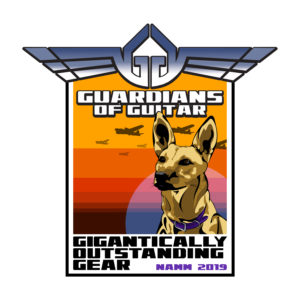
I have attended more NAMM shows than I will ever admit (though, hey, iced teas and movie tickets are reasonable bribes if you must know). They are crowded. They are loud. At times, they are absolutely silly. But they’re also excellent excuses to hang with industry friends and peruse a bounty of new products that you may even want to make your own.
NAMM 2019 had a special significance for me, because it was the first time I attended as my own boss, representing Guardians of Guitar. Furthermore, the show provided me the opportunity to Play It Forward to the manufacturing community—are you getting hip to that GoG mantra of “Play It Forward, Play It Forward” yet?—and devise an award to showcase products that prompted my fellow Guardians and I to go “wow.”
The Gigantically Outstanding Gear Award (funny how that also stands for “GoG”) is our way of saluting gear makers who developed products by either [1] actually listening to players’ needs, [2] innovating something awesome, [3] putting a crazy new twist on an age-old idea, [4] knocking the quality quotient out of the park, or [5] just did something so tremendously cool and fun that it made us smile. We also tried to limit our picks to gear that was attainable for the average working musician, and that will be readily available. For example, the Sundragon amp that we called out in our pre-NAMM article is absolutely a marvel of amp design. But it’s a limited edition, and it was pretty much sold out by the close of the show.
The following “Top 20” GoG Awards were culled from reports by Guardians Barry Cleveland, Jude Gold, Ali Handal, Jimmy Leslie, Gretchen Menn, and I. Obviously, these products haven’t been reviewed yet as many weren’t shipping at the time of the NAMM Show. But we’re not getting into nuts and bolts and analysis and investigations here. These are first impressions from a show that debuts cool new gear toys, and we simply let ourselves geek out at the creative possibilities promised by our 20 award winners.
That said, we now congratulate the GoG Awards inaugural class of 2019…
Abasi Guitars
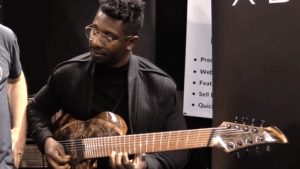
Guardian Jude Gold said it best: “It’s amazing that guitarist Tosin Abasi is being successful with his own launch of guitars, and I love the way he interacts with his users and fans. He brought his personal amp and pedalboard to NAMM, and he had player after player after player up there playing his guitars at his booth—all young badasses. Super inspiring to see.” Click Here for More Info
BOSS Waza Tube Amp Expander

I was initially flummoxed by the rather clinical or software-like model name. Expander? Huh? But, okay, this device is actually a pretty sweet solution for a whole truckload of recording and live applications. There’s a reactive load for cranking up your favorite amp to its optimum roar without the tyranny of extreme volume, and you can route the glorious sound to your DAW, a P.A. system, speaker cabinets, or even headphones. But that’s not all. Unrepentant tweakers can dig into the onboard DSP—or use the software editor accessible via USB—for effects and EQ, virtual cabinets, and virtual mics and mic positions, and then save their carefully crafted rigs for recall later. The Waza TAE is a comprehensive workstation for getting even more tone out of your beloved tube heads and combos. Click Here for More Info
Electro-Harmonix Mono Synth
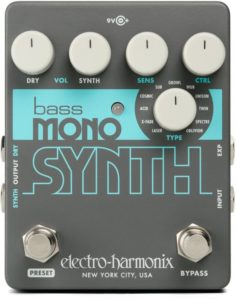
Some of the Guardians liked the EHX Super Switcher for its savvy pedalboard management, but I’m such a “one-effect-at-a-time” player that I’m going to respectfully pass on that one—as awesome as it is for those who dig loop switchers. I was far more intrigued by the creative possibilities of the Mono Synth, as it embraces my jones for twisting guitar solos and riffs just enough to make them weird, but still sound somewhat organic. Like the company’s marvelous “9 Series” of emulators (Mel9, Key9, B9, C9), you can select a classic synth sound and set just the right blend of synth-to-dry-signal to transmogrify a guitar tone into something unexpected and unique that still kicks ass as a guitar tone. Click Here for More Info
Epiphone Limited Edition Peter Frampton Les Paul Custom

Back in the prehistoric era when people went to buildings called “Record Stores” to buy their music, I would often get my mind blown by something the clerks were playing on the speaker system. This was how I first heard Frampton Comes Alive!—before the music was even all over the radio—and it was one of the albums that changed my creative life. (My first “rock” guitar lessons were taught by a jazz player who taught me all the modes, and I thought I always sounded a little “off” when playing solos with friends, so when I first heard Frampton, I was like, “I hear modes! I’m not a freak!”) So I was pummeled by a wave of nostalgia to see that Epiphone is producing a version of Frampton’s historic three-pickup 1954 Les Paul. You can get this beauty two ways: In a Premium Outfit limited to 200 instruments that includes a hand-signed Certificate of Authenticity, or a PRO version limited to 900 guitars. Click Here for More Info
Ernie Ball VPJR Tuner
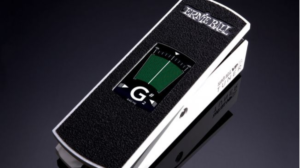
Ernie Ball just made something as simple and essential as a volume pedal a lot more fun, and, well, even more essential. The VPJR Tuner—no surprise—incorporates a tuner into its volume-level treadle. I can almost hear the “so what’s?” But my jaw dropped at how tough and beautiful this pedal is (it comes in a fab selection of colors), and how large, colorful, and readable the display is. You can program the pedal—via a groovy touchscreen—to show the tuner, or a volume level setting, or both (depending on the treadle position), as well as set the frequency of the tuner’s pitch. Must have it! Click Here for More Info
Fender Acoustasonic Telecaster
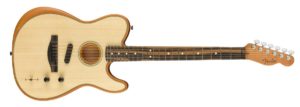
A few years ago, a player of a certain age might be justified in saying, “I’m so done with new Strats and Teles and other Fender whatevers. How many iterations of modified Leo Fender designs can you take?” But the marvelous disrupters who have been working at Fender lately are making sure cynics can no longer say complain about the “same old/same old” from the company. (Well, they could—they’re cynics after all—but they’d be wrong.) Yes, you can buy a basic, time-honored Strat or Tele if you are so inclined (just check out the new American Performer Series), but I’m way more onboard with all the gleeful futzing with the Fender legacy—such as last year’s Parallel Universe models, and 2019’s Alternate Reality series. These guitars are still Fender, but Fender fused with renegade DNA, as if they were pitched into the teleportation pods from The Fly movie. They’re not examples of a company dedicated to cloning its past forevermore. Genius.
Fender’s recasting of the acoustic-electric was another delight. The Acoustasonic Telecaster is rife with organic Fender-isms and technology, and, as a result, it can scream and scuffle like an electric Tele, as well as produce a bevy of accurate acoustic sounds from a dreadnought to a parlor guitar. From a very basic overview, it accomplishes this feat with a 5-position Mod Knob (with two blendable voices for each position) and three pickups—a Fishman undersaddle transducer, a Fishman Enhancer (for amplifying the vibrations of the guitar’s top for percussive playing and resonance), and a Fender noiseless magnetic pickup. It’s quite a little box, and I’m looking forward to new sounds and interesting techniques once forward-thinking players really start decoding its potential. Click Here for More Info
Lâg/HyVibe Smart Guitar
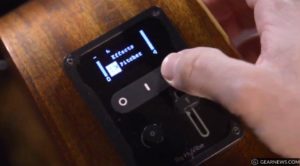
In 2010, when Korg was distributing Lâg Guitars, I was included on a junket to France to meet luthier Michel Lâg-Chavarria and tour the factory. I was so impressed that I asked him to build a custom electric for me that I still own, and I watched his excellent guitar line strive to gain ground in the U.S. marketplace. I hadn’t heard much from the company of late, but several people I talked to during NAMM were very enthusiastic about the Lâg Tramontane acoustics powered by HyVibe technology. I was happy to hear this—kind of like good news from an old friend with whom you lost touch—and the Lâg Smart Guitars sounded wonderful. The HyVibe voodoo—with they call “Vibration Control Technology”—uses the top of the guitar like a speaker, reproducing effects such as reverb, delay, distortion, and chorusing along with the natural sound of the acoustic itself. Even hipper, the HyVibe control panel is wireless, and the effects can be further edited and updated via the HyVibe app from your mobile device. Click Here for More Info
Line 6 Relay G10S Stompbox Wireless System
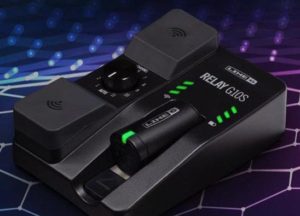
The Line 6 team continues to make wireless performance a simple plug-and-play affair for guitarists, and the G10S Stompbox system is about as easy and elegant as you can get. The receiver is pedal-sized, so it can fit on just about any pedalboard out there—even mini ‘boards for travel gigs. Speaking of traveling, if you’re away from your home base, the G10S will automatically lock onto the strongest available wireless frequency as soon as the transmitter is docked into the receiver. Magically simple! You can also manually choose any one of 11 frequencies, and a cool meter lets you know of any interference affecting the frequency you selected.
I’ve used the G10 transmitter while testing other Line 6 systems, and I never had any problems with it slipping out of the guitar jack or banging against the guitar body, and I move around a lot onstage. The transmitter’s black casing may be a tad more noticeable than a typical 1/4″ cable jack, but if the audience is checking out your jack situation, you may need to review your song choices or punch up your stage show. Most guitarists love simple, especially during the chaos of performing live, and that brings up another benefit of the G10S. As the receiver is on your pedalboard, if something goes south with the wireless frequency, all you need to do is have an “emergency” guitar cable by your feet. If the sound goes dead, you can simply remove the G10S receiver cable going into your first pedal, and plug the guitar cable directly into that pedal and your guitar. I tried it in a mock-up “terror trial,” and it takes no more than 30 seconds. No fear! Click Here for More Info
MXR Dookie Drive
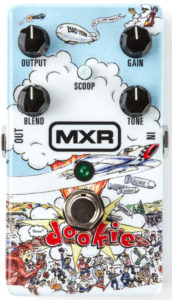
I’m a fuzz-pedal freak, so I really wanted to go for the Billy Gibbons-inspired Siete Santos Octavo Fuzz, because having a 7-band graphic EQ combined with fuzz is like Christmas every day for someone like me. That pedal does kill, BTW. However, I had picked the Dookie for my pre-NAMM report—mostly because Green Day are local heroes back home in the San Francisco Bay Area, and they make some pretty fierce guitar albums—and darned if it isn’t one of the coolest overdrive/distortions happening right now. Bingo! Give that baby a GoG! MXR’s talented and whacky NAMM demo artist Bryan Kehoe said the Dookie is packed with a whole history of Marshall-amp sounds—not just Billie Joe Armstrong’s two modded Marshalls that MXR CSI’d for the pedal—and he’s spot on. What I heard evoked ’60s, ’70s, ’80s, and even ’90s Marshall tones, depending on how the controls were dialed in. I loved every sound in this pedal, and anyone who adores the Marshall mystique will likely agree. Click Here for More Info
Orange Pedal Baby 100

Some of the viewer comments about Orange Technical Director Ade Emsley (shown above) discussing the Pedal Baby on YouTube had a somewhat mean-spirited Spinal Tap vibe. However, I’ve met Ade many times at various NAMM shows, and he is exactly the personality I want to talk to about Orange products. He has that eccentric Englishman thing down pat, but it’s no act, and as an Orange Amps fan, I almost feel his commitment to the company’s unique sound every time I plug into my Orange Tiny Terror, a Bax Bangeetar, or a Rockerverb 1oo. The Pedal Baby is Orange’s take on a portable rig for pedalboard peeps. The idea is that you can be assured of a clean, vibey sound for your pedals or digital workstations no matter what kind of backline you’re provided. All you have to do is plug the Pedal Baby into a speaker cabinet and bypass that busted-up house amp the venue dredged up for you. Taking the Pedal Baby’s approximate 12″x3″x8″ dimensions and 7-lb weight into account, I could easily drop it into a carry-on bag along with my small, analog club pedalboard (or even a HeadRush Pedalboard) and have enough room for cables, spare strings, a couple of magazines, and various other stage necessities. I mean, it’s not a half-stack that goes to 11, but if Nigel Tufnel jumped on a last-minute fly gig to Singapore, I think you might find a Pedal Baby 100 in his Aspinal of London overnight bag. Click Here for More Info
Pigtronix Resotron
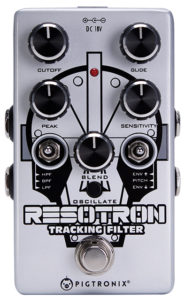
Here’s another fab melding of monophonic synth technology for guitar—in fact, the analog filter embedded in the control center of the Resotron is based on the SSM2040 chip that powered the Prophet 5 synthesizer. Of course, the engineers at Pigtronix didn’t design this pedal as a ’70s icon, there are some cool features that push the Resotron out of the rote envelope follower category—such as a pitch-following filter that tracks the notes you play, rather than your attack. The NAMM demos illustrated that you can get some pretty period-correct synth tones from your guitar—and that was nice—but I’m not a guitarist pining to be a keyboardist, so the sonic anarchy this pedal promises was the thing that got it a GoG Award. Just like exploring the knobs of an old-time synth, twisting the Resotron’s knobs as you play can unveil some crazy timbres that point to new riffs, solos, licks, and other wonderful moments of creative inspiration. Click Here for More Info
PRS SE Paul’s Guitar
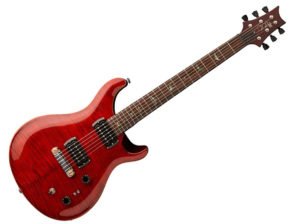
I had picked the new SE Santana Singlecut Trem for my pre-NAMM report, because Carlos Santana always cares deeply about tone and “playing it forward” to those who wish to follow in his creative footsteps. It’s a great guitar, to be sure. But after seeing and hearing the SE Paul’s Guitar at NAMM, I have to give it the edge for our GoG Award. For one thing, this model really does bring Paul Reed Smith’s imagination—as well as an innovation or two from his luxurious PRS Private Stock line—to everyday players. In this case, it’s the ability to put one or both humbuckers in single-coil mode—a feature that has never been offered outside of the core series or Private Stock. In the immense true-value proposition of the affordable SE line, Paul’s Guitar was stunning to behold—the finishes are like a sultan’s jewels—and no construction flaws were apparent. So as brilliant as Santana is as a player and tone king, it’s hard to match the personal guitar from the man who builds Santana’s guitars, as well as models for so many other players. Thanks for bringing your genius downstream, Paul! Click for More Info
Reverend Greg Koch Signature Gristlemaster

I’ve known Greg Koch for a while, but I didn’t get to really hang out with him until we both made the scene at the 2017 Guinness Guitar World Record Festival in Wroclaw, Poland. Watching him close up onstage at the festival and at a show in the city later on, I was rather devastated by how Greg can play anything (including practically any lick ever laid down by any guitarist in the entire history of guitar) and do it with a killer tone and a buoyant sense of humor. (No surprise, then, that his signature model is called the “Gristlemaster.”) Reverend Guitar’s manifestation of Greg’s appreciation for vintage T-style models may look like, well, a common T-style guitar, but this is Greg, so it ain’t. First, the guitar includes his signature Fishman Gristle-Tone pickups, and a push-button on the control plate kicks in more “gristle” in the mids. (These are active pickups, but they can be recharged via a USB port at the input jack—smart!) Then, the body is chambered under the scratch guard to add just enough resonance and snap. There’s also a six-bolt neck attachment that improves sustain, and other nifty features. Ultimately, if Greg made this baby to handle all of his musical needs—which are formidable—then a common mortal such as myself will likely find everything I’d ever need to make some awesome noises. Click Here for More Info
Rockboard BigToe and StomPete Footswitch Toppers
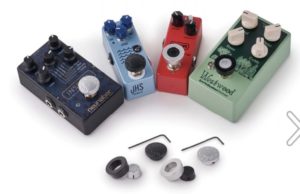
When I first saw Rockboard’s flat patch cables at the 2017 NAMM Show, I knew that my pedalboard life had changed for the better. I could fit more pedals on my board (as the cable’s jack size was significantly diminished), and all the cables seemed so much neater. Rockboard is committed to producing surprisingly simple but smart and innovative pedalboard solutions—such as Compact Pedal Connectors, PedalSafe covers, and QuickMounts (for their pedalboard line)—and I love the whole idea of these footswitch toppers, because they help me. I often wear Doc Martens onstage, and even though I am a short little dude, the footprint of those boots is hella vast for their relative size. So if I’m the least bit off the “bullseye,” I end up stomping on two switches simultaneously, which sucks. I am hoping that a savvy application of these toppers will save me embarrassment in the future, or prevent the horror of performing in my socks. Saved by Rockboard again! Click Here for More Info
Sheeran By Lowden

Whenever a Lowden guitar would make its way to the Guitar Player offices, it was kind of an event, because the Irish manufacturer produced absolutely beautiful-looking, gorgeous-sounding instruments. Most of the time, these guitars were very expensive propositions, and a few tears would be shed when we had to send them back home after a review was completed. But in a move that became one of the big discussion items at NAMM, George Lowden (at left above) and superstar Ed Sheeran teamed up to produce more affordable, small-bodied Lowdens aimed at young people. In Sheeran’s words: “There are fewer guitar bands and fewer artists using guitars now, and not as many kids picking up guitars. That is something I would like to change by getting these great quality guitars into kids’ hands and encouraging them to learn and progress.” That commitment certainly aligns with our Guardians of Guitar mantra to “Play It Forward,” so Lowden and Sheeran deserve about a trillion kudos for the project. Furthermore, all of the guitars are crafted from sustainably sourced woods (which include fallen trees and reclaimed spruce). Although less expensive than upscale Lowdens, The Sheeran By Lowden line is still a ways from a budget brand. Pre-sale pricing looked to be in the $825-$1,300 range. Click Here for More Info
Supro Blues King 12

I’ve never considered myself much of a blues-influenced musician, and, truth be told, I was in the Supro booth to check out the David Bowie guitar. So when Supro president David Koltai pointed me at the Blues King, I kind of did my polite smile and walked back to the Bowie. Then, I heard someone play it. What a roar! I immediately snapped to attention and tried it myself, and I forgot the “blues” appellation entirely, because this amp was producing a bevy of ’60s rock tones that I loved. When I could dial in decent approximations of British Invasion jangle, Beat Club grit, and full-on Kinks, I was sold. This 15-watt combo is a monster! What’s in a name, anyway? Click Here for More Info
TC Electronic June-60
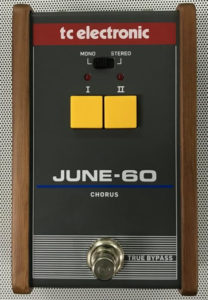
How awesome is it that the normally futuristic tech team at TC Electronic came up with something as retro-fun as the June-60? I don’t know what has been going on in the development lab of late, but “bravo” to whoever came up with this gizmo. The June-60 recreates the chorus effect found on Roland’s Juno-60 synthesizer—one of the sonic staples of music from the ’80s—and TC Electronic even went the extra mile to pay homage to the Juno-60’s look, right down to the buttons and wooden panels. The pedal brings back memories, because the Juno-60 was the first synthesizer I owned, back when I erroneously believed I had the chops to compose film soundtracks. However, I did manage to score a live theater piece by playwright Norah Holmgren that I entitled “Inferno” after Dante’s epic poem. The Juno-60’s chorus was seductive during the compositional process—too beguiling as it turned out, because I think I used it for every sound on the score. It was simultaneously embarrassing and comforting to hear that vintage effect again. Just like smells and images and unexpected feelings, sounds can trigger memories, too, and I appreciate that TC Electronic priced this beauty at just $49, which means being blissfully haunted by my past won’t cost me big time. An interesting footnote is that I kept the concept with me for years until it resurfaced to inspire the libretto for Gretchen Menn’s beautiful Abandon All Hope project. Click Here for More Info
Tech 21 Fly Rigs

Since introducing the fabulous Fly Rig concept in 2014, Tech 21 has continued to tinker with near-perfection and introduce new variations. The company released a trio of Fly Rigs at NAMM, and we were all hard-pressed to pick just one award winner. Happily, we make the rules here, so we simply went ahead and named all three as Gigantically Outstanding. The Fly Rig 5 got a version 2.0 update with new features such as a switchable pre/post boost and an independent reverb. Richie Kotzen became the first artist with a signature Fly Rig, and his using the device out on the road promoted a few refinements for his RK5 v2, such as an on/off button for the SansAmp section. That brings us to the latest signature artist for the Fly Rig series, Rammstein’s Paul Landers. I picked this for my pre-NAMM report, and it didn’t disappoint. The clean and dirty sounds are vibey and fearsome, and the Boost and Punch modes get it done when you want a solo or riff to burst out of the band mix onstage. All three of the new Fly Rigs can fit into a briefcase (of course), and the tones are organic, impactful, and totally rockin’. Pick one that fits your particular style and never feel like you have to compromise your sound when you can’t drag your full rig to a show or recording session. Click Here for More Info
Teisco Delay
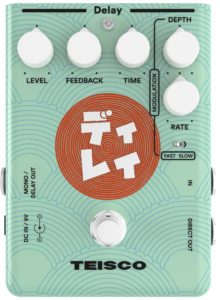
There’s a bit of an instant replay here, as Teisco and Harmony Guitars—under the direction of the BandLab team—announced some products at the 2018 NAMM show that were still being shown this year. A company representative acknowledged the long-ish gestation, stating, “Now, we’re ready to get these products out there.” That would be a good thing, because everything we tried certainly deserves to drop into the hands of willing players. The Harmony models retain the vintage mojo that guitarists-in-the-know will crave, and they are also good options for players looking for something a bit different than the “usual suspects.” That said, I opted for the Teisco Delay as an award winner, because of its ability to deliver classic delay goodness and modulated cyclones of weird. In fact, I watched two Teisco demo artists work the Delay at two separate times, and each of them choose different paths—evoking the age-old angel/devil on your shoulder conundrum. Artist One went for the conventional, and the pedal delivered taut, articulate echoes that ranged from rockabilly slapback to The Edge-styled orchestras of delay. Artist Two was a bit more unhinged (hahaha), and focused on the pedal’s modulation section to craft truly alien soundscapes. The duality made me laugh, and it also made me love this pedal. Click Here for More Info
Steve Vai Vaideology

Through all the years I’ve interacted with Steve Vai during my years at Guitar Player, he has always been enthusiastically committed to helping other players, and extremely gracious with his time in doing so. But even someone with Vai’s energy and outreach can’t help every beginner, intermediate, or advanced guitarist needing a bit ‘o’ wisdom from the master, so to speak. So, we definitely feel a GoG Award is warranted for his new book, Vaideology: Basic Music Theory for Guitar Players [Hal Leonard]. This may be one of the few music-theory books that players don’t need to fear. It’s a comprehensive method, to be sure, but Vai’s nurturing and encouraging style gets you through even those bits you might consider scary. It’s so great that Vai obviously wrote this from his heart, and to complete a personal mission. “One of the questions I’m usually asked by aspiring guitar players is, ‘How much music theory do I really need to know, and is it necessary?'” he explains. “My answer is usually, ‘You don’t need to understand music theory at all to be an effective player, but it will always help to at least understand the basics.’” Click Here for More Info




One thought on “The Inaugural GoG Gear Awards!”